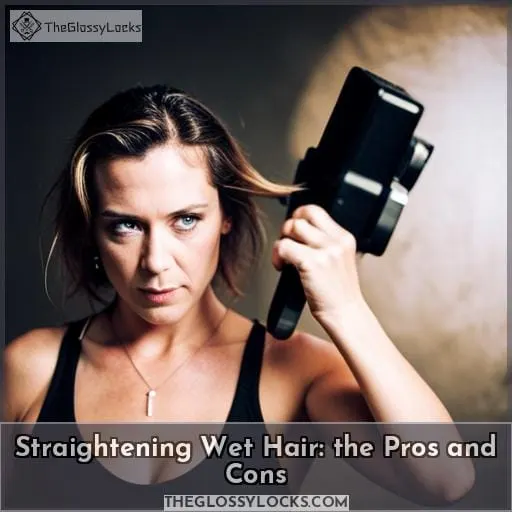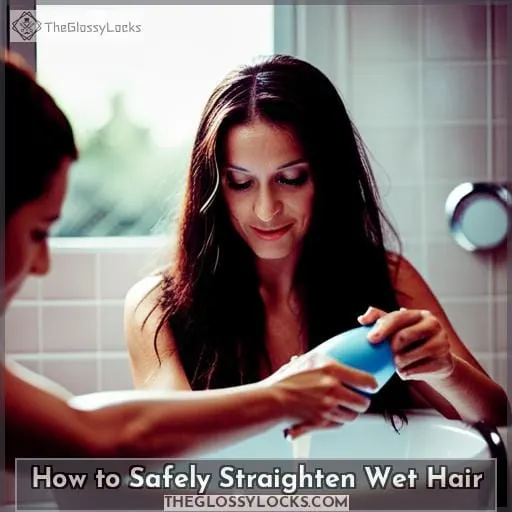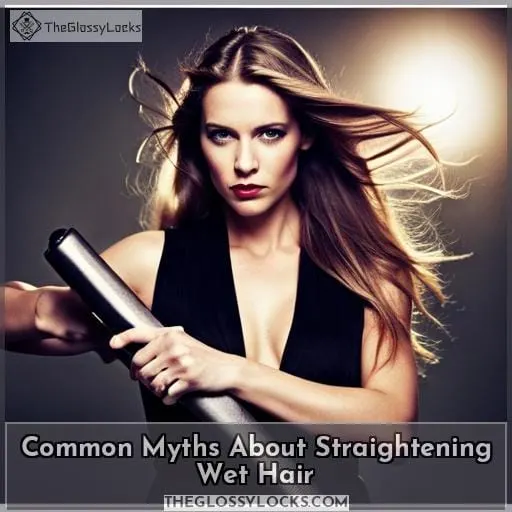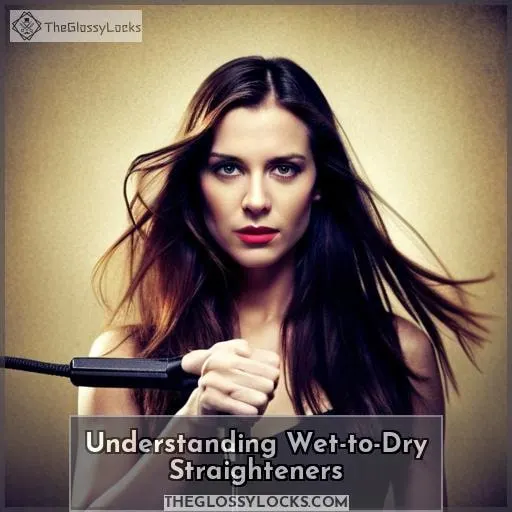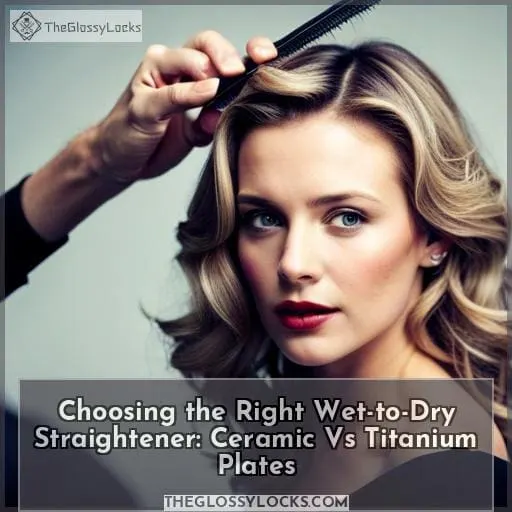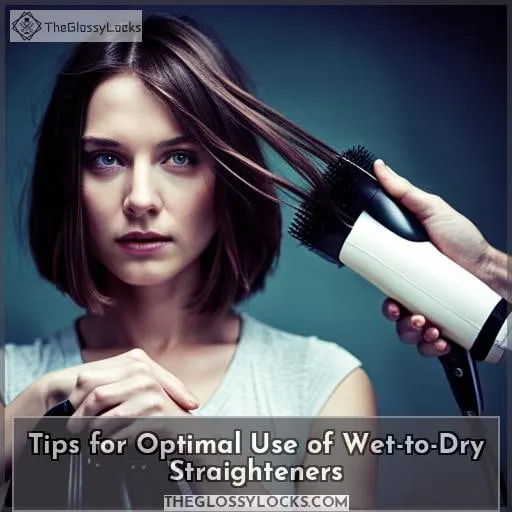This site is supported by our readers. We may earn a commission, at no cost to you, if you purchase through links.
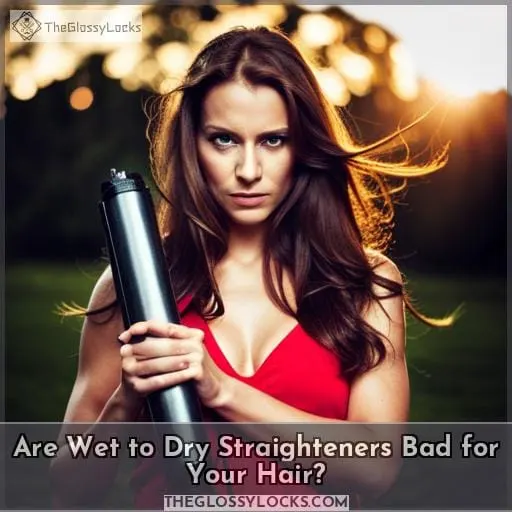
In this article, we’ll delve into the pros and cons of using these innovative styling tools. We’ll also provide tips on how to safely straighten wet hair and debunk common myths surrounding this technique.
Table Of Contents
- Key Takeaways
- Straightening Wet Hair: the Pros and Cons
- How to Safely Straighten Wet Hair
- Common Myths About Straightening Wet Hair
- Understanding Wet-to-Dry Straighteners
- Choosing the Right Wet-to-Dry Straightener: Ceramic Vs Titanium Plates
- Tips for Optimal Use of Wet-to-Dry Straighteners
- Editor’s Choice: Remington Wet2Straight Flat Iron Review
- Frequently Asked Questions (FAQs)
- Are wet-to-dry straighteners more damaging to hair than traditional flat irons?
- How does the steam hydration therapy in the Remington Wet2Straight Flat Iron work to protect hair from over-drying?
- Can wet-to-dry straighteners be used on all hair types?
- What are the benefits of using a wet-to-dry straightener instead of drying hair with a blow dryer and then using a traditional flat iron?
- Are there any specific precautions or tips for using wet-to-dry straighteners to minimize damage to the hair?
- Conclusion
Key Takeaways
- Wet to dry straighteners can be damaging to hair if not used properly.
- It is important to use a heat protectant before using a wet to dry straightener.
- Choosing the right wet to dry straightener is crucial for minimizing damage.
- Optimal use of wet to dry straighteners requires following specific tips and guidelines.
Straightening Wet Hair: the Pros and Cons
When it comes to straightening wet hair, there are both advantages and disadvantages to consider.
On one hand, straightening wet hair can save time as you can dry and style your hair simultaneously. It also allows for a style reset if you want to change up your look without washing your hair first.
However, there’s the risk of heat damage and potential breakage when applying high temperatures directly to wet strands.
Ultimately, it’s important to weigh these pros and cons before deciding whether or not straightening wet hair is right for you.
Advantages of Straightening Wet Hair
When straightening wet hair, you can conveniently and efficiently achieve your desired style more frequently.
- No heat damage: Wet-to-dry straighteners use steam or moisture from the hair to dry and style it, reducing the risk of heat damage.
- No frizz: By smoothing out the strands while they’re still damp, these straighteners help eliminate frizz for a sleeker look.
- Less damage: Straightening wet hair can cause less breakage compared to using heated tools on dry hair.
With faster drying and easier styling, using a wet-to-dry straightener can be a time-saving option for those looking for quick and convenient ways to achieve their desired hairstyle without compromising their precious locks.
Disadvantages of Straightening Wet Hair
Straightening wet hair can have its drawbacks, such as an increased risk of damage and potential for breakage.
When heat is applied to wet hair, the water in the hair can reach high temperatures and cause damage.
Wet-to-dry straighteners may claim to protect against these issues but without more information on their technology it’s difficult to say if they’re truly effective.
It’s generally recommended to avoid straightening wet hair and instead wait until your hair is completely dry before using any heat styling tools.
How to Safely Straighten Wet Hair
To safely straighten wet hair, there are a few options available.
One method is to use a blow dryer and round brush combination, which allows you to gradually dry and style your hair.
Another option is using a wet-to-dry styler, but it’s important to note that this can still cause damage if not used properly or without heat protectant.
Regardless of the method chosen, always remember to use heat protectant prior to styling in order to minimize potential damage caused by high temperatures.
Using a Blow Dryer and Round Brush
To safely straighten wet hair, you should regularly use a blow dryer and round brush.
- Towel dry your hair and let it air dry partially before using any heat styling tools.
- Use a blow dryer with the concentrator nozzle attachment to pre-dry your roots.
- Section off your hair and use a large round brush while blow drying to smooth and straighten each section.
- Finish with a cold shot from the blow dryer to set the style.
For best results, choose high-quality blow dryers specifically designed for wet hair like the Dyson Supersonic Hair Dryer or GHD Air Professional Performance Hairdryer, along with round brushes made for wet hair such as Denman Classic Styling Brush or Olivia Garden NanoThermic Ceramic + Ion Round Thermal Brush.
By following these steps and using appropriate tools, you can minimize heat damage and reduce the risk of hair breakage when straightening wet strands.
Using a Wet-to-Dry Styler
To safely straighten wet hair, grab your wet-to-dry styler and get ready for sleek, frizz-free locks.
Wet-to-dry stylers are designed to dry and straighten your hair simultaneously, saving you time and effort. While some user reviews rave about the effectiveness of these stylers, it’s important to understand the science behind them.
The steam hydration therapy used in these stylers claims to protect hair from over-drying, but without more information on how this technology works, it’s difficult to determine if they’re truly better than other flat irons.
To minimize heat damage when using a wet-to-dry styler or any other flat iron on wet hair:
- Towel dry your hair before using the styler.
- Use a heat protectant prior to styling.
- Avoid applying excessive heat by selecting an appropriate temperature setting for your specific hair type.
- Finish with a nourishing oil or conditioner for added protection against potential damage caused by high temperatures.
Importance of Heat Protectant
Before straightening your wet hair, it’s essential to apply a heat protectant for added protection and minimize damage.
A heat protectant is a product specifically designed to create a barrier between your hair and the high temperatures of styling tools. It helps to reduce moisture loss, prevent breakage, and shield your strands from thermal damage.
There are various types of heat protectants available, such as sprays, serums, creams, or lotions.
To use a heat protectant effectively on wet hair, simply spray or apply it evenly throughout your damp locks before using any hot styling tool.
Common Myths About Straightening Wet Hair
Let’s debunk some common myths about straightening wet hair.
First, the myth that blow dryers are used on wet hair should be addressed – blow dryers are meant to be used on damp or partially dried hair.
Second, there’s a misconception that flat irons can safely be used on wet hair as long as heat protectant is applied – in reality, it’s recommended to only use a flat iron when your hair is completely dry.
Lastly, the myth that you can straighten wet hair with a wet-to-dry flat iron needs clarification – using any type of heat styling tool directly on wet strands can cause damage and should be avoided for optimal health of your locks.
Debunking the Myth About Blow Dryers
Don’t believe the myth that blow dryers are only used on wet hair. Here are four reasons why blow dryers can be used for straightening wet hair:
- Efficient Drying: Blow drying not only speeds up the process of getting rid of excess moisture in your mane, but also helps prepare it for further styling steps without having you wait around impatiently.
- Sleek Results: By combining a powerful blast from the nozzle attachment along with skillful maneuvering of a round brush through sections of partially dried locks, you’ll find yourself achieving enviable smoothness effortlessly!
- Heat Protection is Key: Just as when employing other hot hairstyling tools such as flat irons or curling wands, applying an effective thermal protectant spray prior will shield delicate strands from unnecessary harm caused by direct exposure to high temperatures.
- The Perfect Base: For those wanting ultimate sleekness in their final look after complete air-drying isn’t possible due time constraints, beginning at about 80% dried state allows one more control over the outcome.
Addressing the Myth About Flat Irons
Straightening wet hair with a flat iron isn’t as safe or effective as some may believe.
While there are claims that certain flat irons, like the Remington Wet Straight Iron, use steam hydration therapy to protect hair from over-drying, it’s unclear how this technology works.
The Beauty Brains and AleV agree that rapidly heating wet hair with a flat iron can still cause damage.
It’s recommended to use a flat iron on dry hair with heat protectant for optimal safety and protection against heat damage.
Clarifying the Myth About Wet-to-Dry Flat Irons
Curious about whether wet-to-dry flat irons are really as damaging to your hair as some myths suggest? Let’s separate fact from fiction.
- Wet-to-dry straighteners claim to use steam hydration therapy for protection, but it’s unclear how this technology works.
- Reviews and expert opinions indicate that rapidly heating wet hair can still cause damage.
- Without more information, it’s difficult to determine if these straighteners are truly better than regular flat irons.
- To be safe, experts recommend using heat protectant and styling on dry hair.
Understanding Wet-to-Dry Straighteners
To understand wet-to-dry straighteners, it’s important to know how they work and the key differences between them and blow dryers.
Wet-to-dry straighteners are designed to be used on damp hair, allowing you to skip the step of fully drying your hair before styling.
These straighteners have special vents that release steam as they glide through your hair, helping to evaporate excess moisture while simultaneously smoothing and straightening your locks.
Unlike blow dryers which use hot air to dry the hair first, wet-to-dry straighteners combine both drying and styling in one tool for a more efficient process.
How Wet-to-Dry Straighteners Work
Wondering how wet-to-dry straighteners actually work?
These innovative hair tools utilize steam and heat to transform wet hair into a sleek, dry style.
The process involves the use of special plates that not only straighten the hair but also release steam to hydrate and protect it from heat damage.
By combining the functions of a blow dryer and flat iron in one device, wet-to-dry straighteners save time and eliminate the need for multiple styling tools.
The temperature settings on these devices allow you to adjust according to your hair type, ensuring optimal results without causing excessive damage.
Difference Between Blow Dryers and Wet-to-Dry Straighteners
To understand the difference between blow dryers and wet-to-dry straighteners, let’s delve into how these two hair styling tools work.
- Heat Damage:
- Blow dryers use hot air to evaporate moisture from wet hair,
- While wet-to-dry straighteners claim to be able to style damp or even soaking-wet hair without causing damage.
- However, applying high heat directly onto wet strands can lead to excessive drying and potential damage.
- Hair Type:
- Blow dryers are suitable for all hair types as they allow you to control the level of heat and airflow.
- Wet-to-dry straighteners may not be ideal for those with very thick or coarse hair since it could take longer for the strands to fully dry during styling.
- Product Safety:
- When using a blow dryer on damp or partially dried hair, it’s crucial always remember product safety by utilizing a heat protectant spray before applying any direct heat source like flat irons – whether they’re designed specifically for use on damp locks or not – should only be used when your tresses are completely dried out first.
Choosing the Right Wet-to-Dry Straightener: Ceramic Vs Titanium Plates
When choosing a wet-to-dry straightener, it’s important to consider the type of plates that are used.
Ceramic plates offer several benefits, such as even heat distribution and reduced frizz.
On the other hand, titanium plates heat up quickly and maintain high temperatures consistently, making them ideal for thick or coarse hair types that require higher heat settings.
Understanding these differences can help you choose the right straightener for your specific hair needs.
Benefits of Ceramic Plates
To choose the right wet-to-dry straightener, you’ll want to consider the benefits of ceramic plates.
Ceramic plates are a popular choice for many because they distribute heat evenly, preventing damage to your hair.
The even heat distribution ensures that no one section of your hair is exposed to excessive heat, reducing the risk of overheating and causing damage. With ceramic plates on your wet-to-dry straightener, you can achieve sleek and shiny results while keeping your hair healthy and protected.
Benefits of Ceramic Plates:
- Distribute Heat Evenly
- Prevent Damage
- Smooth Hair
- Reduce Frizz
Benefits of Titanium Plates
If you’re deciding between ceramic and titanium plates for your wet-to-dry straightener, you might be wondering about the benefits of titanium plates.
Titanium conducts heat evenly, which means that it can distribute the heat more uniformly across your hair strands, resulting in a smoother and more efficient straightening process.
In addition to this, titanium plates last longer than ceramic ones since they’re more durable and resistant to rust and corrosion. This makes them a great choice for those who want a long-lasting straightener that can withstand regular use without losing its effectiveness.
Tips for Optimal Use of Wet-to-Dry Straighteners
To achieve optimal results and minimize potential damage when using wet-to-dry straighteners, there are a few key tips to keep in mind:
First, it’s important to properly prepare your hair by towel drying it and allowing it to air dry partially before using any heat styling tool.
Second, make sure to select the right temperature setting for your hair type – lower temperatures for fine or damaged hair and higher temperatures for thicker or coarse hair.
Lastly, after straightening, finish off with a protective hair oil to provide an extra layer of defense against heat damage.
Preparing Your Hair Before Straightening
Before straightening your hair with a wet-to-dry straightener, make sure to properly prepare your hair for optimal use.
- Towel dry your hair before using the straightener.
- If time permits, blow dry your roots to remove excess moisture.
- Apply a heat protectant spray or serum to shield your strands from damage.
- Use the cold shot setting on the dryer or finish with a blast of cool air after straightening.
- Finish off by applying a small amount of hair oil for added protection and shine.
Using the Right Temperature Setting
Now let’s talk about setting the right temperature for optimal use of wet-to-dry straighteners.
As you continue to prepare your hair before straightening, it’s important that you choose the appropriate heat level for your hair type and condition.
Wet-to-dry straighteners typically have adjustable temperature settings ranging from 150 degrees Fahrenheit to 350 degrees Fahrenheit.
For fine or damaged hair, it’s recommended to use a lower temperature between 150-200 degrees Fahrenheit.
Normal or medium-textured hair can be styled at temperatures around 250-300 degrees Fahrenheit, while thick or coarse hair may require higher temperatures up to 350 degrees Fahrenheit.
Finishing With a Hair Oil for Protection
To protect your hair from heat damage, make sure to finish the straightening process with a hair oil for added protection.
Here are four reasons why using a hair oil is beneficial when using wet-to-dry straighteners:
- Heat Protectant: Hair oils act as a barrier between your strands and the high temperatures of the straightener, reducing damage.
- Seal in Moisture: The oil helps seal moisture into your hair, preventing it from becoming dry and brittle.
- Prevent Frizz: Applying a small amount of hair oil can help tame frizz and flyaways, leaving you with sleek and smooth locks.
- Enhance Shine: Hair oils add shine to your finished hairstyle, giving it that healthy-looking luster.
By incorporating this final step into your routine, you can reduce potential damage while achieving beautiful results with wet-to-dry straighteners.
Editor’s Choice: Remington Wet2Straight Flat Iron Review
Continuing the discussion from the previous section, let’s take a closer look at our editor’s choice: the Remington Wet2Straight Flat Iron.
This versatile flat iron is designed to be used on both wet and dry hair, offering convenience and efficiency in one tool. With its ceramic plates and steam vents, it claims to effectively straighten and dry your hair with less damage compared to traditional methods.
The 420 degrees of professional-grade heat can be adjusted among 30 settings, allowing you to find the perfect temperature for your hair type.
User reviews for the Remington Wet2Straight Flat Iron are mostly positive, with many raving about its efficacy in styling wet or damp hair without causing excessive heat damage. However, some users have reported issues such as lights not turning on or receiving open products upon delivery.
While this flat iron offers a convenient solution for those who want quick results by combining drying and straightening processes into one step, it’s important to remember that using any hot styling tool carries potential risks if not used properly.
To ensure safety while using this flat iron or any other similar product, always follow instructions carefully and use appropriate temperature settings along with a heat protectant product.
In conclusion,
the Remington Wet2Straight Flat Iron offers convenience by eliminating the need for separate drying before straightening; however proper usage techniques are recommended due to potential risks associated with high temperatures.
Frequently Asked Questions (FAQs)
Are wet-to-dry straighteners more damaging to hair than traditional flat irons?
Yes, wet-to-dry flat irons can cause more damage. They apply high, direct heat to wet strands, boiling the water inside them, making hair prone to breakage.
Let hair dry fully before using any hot tool for sleek styles without ruining your strands.
How does the steam hydration therapy in the Remington Wet2Straight Flat Iron work to protect hair from over-drying?
Unfortunately, Remington doesn’t provide enough specific details about how their steam hydration therapy technology works to determine if it truly protects hair from over-drying when using the Wet2Straight iron on wet hair.
More transparency from the company is needed regarding the science behind this feature’s claims.
Can wet-to-dry straighteners be used on all hair types?
Yes, wet-to-dry straighteners can be used on most hair types. However, very curly or coily hair may require additional heat protection and prep work for best results.
Proceed cautiously, using lower temperatures and heat protection to minimize potential damage.
What are the benefits of using a wet-to-dry straightener instead of drying hair with a blow dryer and then using a traditional flat iron?
Using a wet-to-dry straightener allows you to style from start to finish in one step, saving time by eliminating blow drying.
The built-in ventilation dries hair gently while infusing conditioning steam to smooth, minimizing exposure to high heat that can lead to damage when flat ironing wet strands.
Are there any specific precautions or tips for using wet-to-dry straighteners to minimize damage to the hair?
Always apply a heat protectant first to help minimize damage.
Use the lowest temperature setting necessary to achieve your desired look.
Work in small sections and don’t leave the straightener on one area for too long.
Avoid going over the same piece of hair more than 1-2 times.
Let your hair cool between passes.
Conclusion
To answer the burning question, wet-to-dry straighteners can indeed be bad for your hair if not used properly.
While they offer convenience and time-saving benefits, excessive heat and lack of proper protection can lead to damage and breakage.
However, by following safe techniques, such as using a heat protectant and adjusting the temperature setting, you can minimize the risks.
It’s crucial to understand the differences between blow dryers and wet-to-dry straighteners and choose the right one for your hair type.
Ultimately, the health of your hair depends on proper usage and care.

